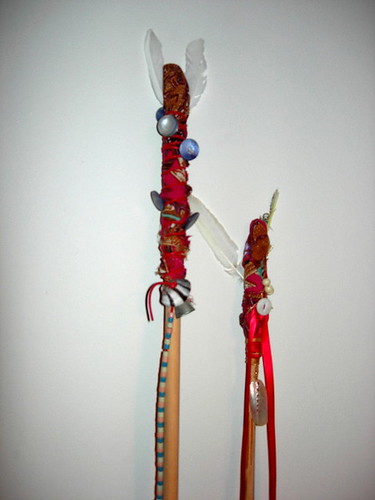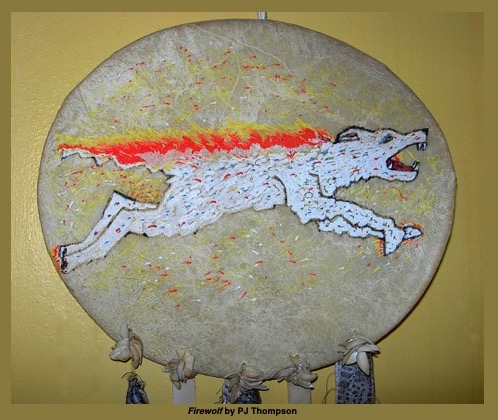
What are prayer sticks? A way of making a prayer manifest in physical form, an offering to the gods and spirits in hope they will please them and persuade them to grant your prayer.
There are many ways to make prayer sticks, many traditions, including fake ones. If you type prayer sticks into Google, you’ll see what I mean. They aren’t strictly an American Indian tradition, but exist in many forms in many cultures. The thing is: one tradition will have you plant them in the earth to soak up the earth’s magic; another will tell you they must hang in trees and never touch the earth or the magic is void. I suspect the “truth” is more along the lines of “as you think, so shall it be.”
The way I was taught is this: first, get yourself a stick. Now, some traditions say it has to be a stick gathered from a certain kind of tree (the kind of tree varying depending on who you’re talking to), stripped of its bark and sanded; others say leave the bark on; still others say the stick itself is less important than the intent put into it. A piece of wooden dowling will do if you do not have a tree handy to harvest switches from. So, I got me some wooden dowling. Second, on the top part of the stick you paint or write your prayer in some kind of permanent medium. Next, you cover up the prayer with bright cloth or leather and bind it with string or leather thongs. I have a special piece of batik cloth which a soldier brought back from Vietnam for his mother. She gave it to my mother, who gave it to me. I use it for all my ceremonial art pieces. Then you decorate the cloth—with things of a more natural bent, not plastic. In my case, I used shells, bells, tile beads, shell buttons (some dyed blue, some natural), bone beads, ribbons, and feathers. Feathers are very, very important. Almost every tradition I’ve read of speaks of feathers. They help the prayer fly up to the gods, you see. After all this—in the way I was taught—you find a secluded place where you can plant your stick in the ground, somewhere where it’s not likely to be disturbed because if someone touches it, the magic all goes away! You visit the stick every day at sunset or sunrise for ten days, and reiterate the prayer inked on it. After ten days it becomes just another decorated stick and you can pluck it from the ground again and do whatever you like with it. I placed mine on display in my room, and they have journeyed around with me now from place to place to place to place.

And no, I will not say what the prayers were for. I have a superstition of my own, that telling the prayer will make the magic all disappear. In fact, I’m only totally sure what one of those prayers was for (both were done many years ago). I also have a superstition about unwrapping the stick and peaking at the prayer. See above about magic disappearing. The one I’m sure of came true, so the stick did the trick. I suspect I know what the other one was, but I’m not entirely sure, and if it was what I think, then the gods found my prayer stick and me wanting. The prayer did not come true. No harm, no foul. Prayers sticks are about asking, not about receiving.
I did a lot of asking back in the day, back in that day.
This post is really about cultural appropriation
(more…)






